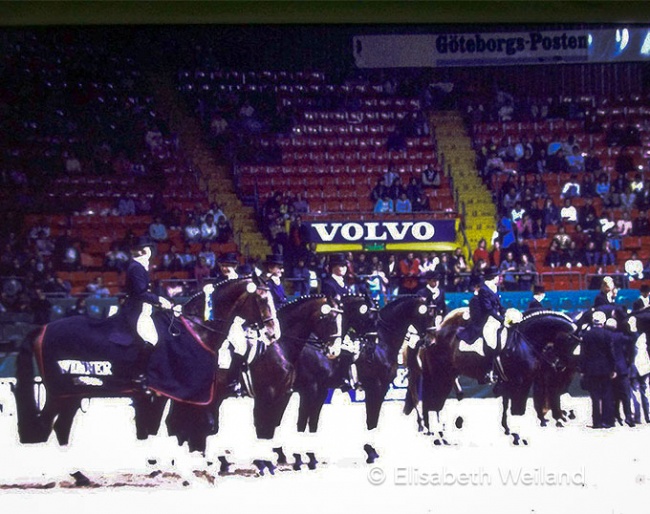
-- Text by Silke Rottermann, Photos © Elisabeth Weiland - no reproduction allowed
The fourth World Cup Final in dressage at the end of March 1989 set several new records: A completely sold out house, a record field of 14 finalists, a winning ride that absolutely defied gravity and brought tears to the extremely enthusiastic crowds whose knowledge was highlighted by judges, riders and journalists alike.
Gothenburg and its „Scandinavium“ already were hosts to several jumping World Cup finals then, so it was a little milestone in the young history of the World Cup in dressage, even though the perfectly organized location and the outstanding winner could not completely wash away the fact that the international field of riders from 11 nations did not completely include the best of the discipline at that time.
Qualifiers for the 1989 World Cup Final
The 1988 / 1989 World Cup season for the very first time saw four qualifying leagues, two in Europe and two in North America.
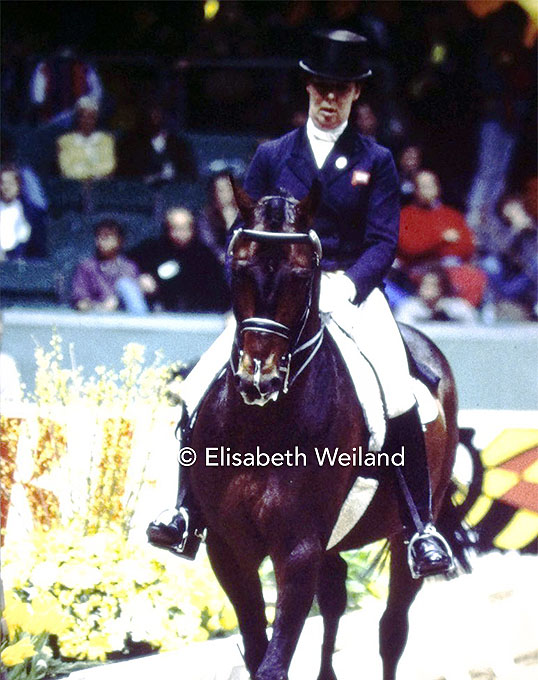
Thirteen qualifiers were offered to the riders who competed in the „Western European League“ which was won by British Jennie Loriston-Clarke on her British bred stallion Dutch Gold—both had won three qualifiers. Title defender Christine Stückelberger had only participated in one qualifier, she won on home-soil in Chalet-à-Gobet near Lausanne with Gauguin de Lully CH.
The US league saw Danish Olympian Bent Jensen and Ariston as winners, so second placed Kathy Connelly made the trip to Europe with her horse Enterprise to represent the USA. The winners of the Canadian league, World Cup crowd favorites Cindy Ishoy and Dynasty, could not travel as the magnificent Hanoverian had sustained a tendon injury, so Olympic team-mate Ashley Nicoll (now Holzer) and her Swedish stallion Reipo travelled instead.
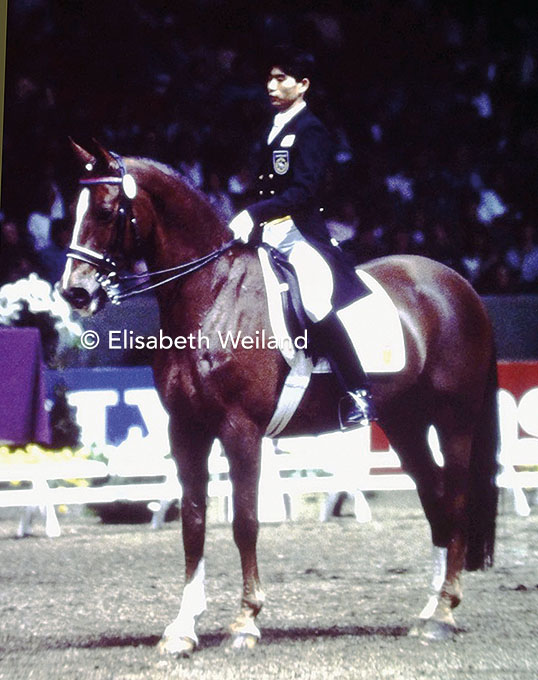
The winners of two qualifiers each, Karin Rehbein with Nektar and Otto Hofer with Andiamo, both declined to start at Gothenburg as did young Pia Laus who had won in Stuttgart for Italy.
A wild-card was awarded to Korean rider Jung-Kyun Suh who had been one of the surprises of the Seoul Olympics a year before in 1988, where he qualified for the Grand Prix Special with the former Dr. Reiner Klimke ride Pascal (by The Stranger xx).
World Cup Final 1989
The introduction of a World Cup series in the mid 1980s did not come overnight and caused animated discussions before and in its first years. Even very renowned judges feared that more publicity for dressage would go on the expense of quality and classical principles. Others may judge if the latter happened over the decades, but the final in 1989 proved the enormous popularity which the young series has brought to dressage.
The „Scandinavium“ in Gothenburg was not only completely sold out with almost 11 000 people, it also saw an extremely knowledgeable crowd which knew exactly when to enthusiastically cheer and applaud for and when to sit still and not disturb horses and riders.
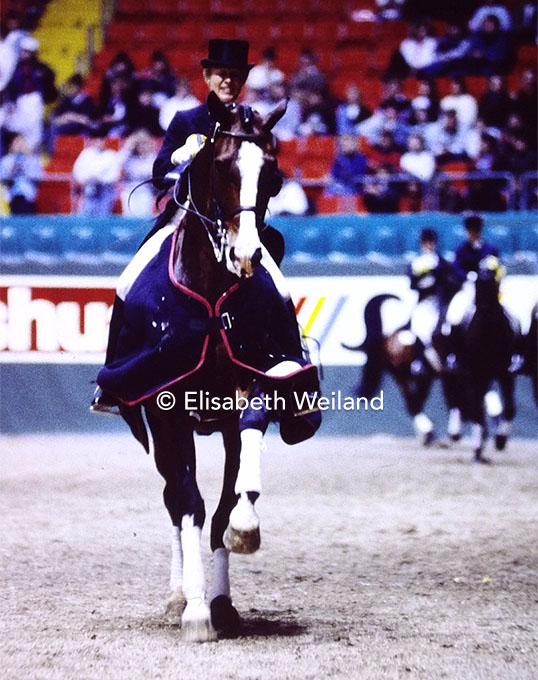
Corlandus, this majestic Holsteiner by Cor de la Bryère out of Gustia by Landgraf I, possessed this unique ability to give the impression to defy gravity despite his size. His elegance, sparkling power, the lightness in all the collected movements and his expression were superior and there was never any doubt he would not add a World Cup final to his impressive list of accolades. Not even an early error of course in the freestyle, Margit Otto-Crépin kept her cool when both were running behind music for a while, could endanger the supremacy of this pair. Their win was a proof that freestyle riding does not necessarily need to be a grave-digger of classical dressage, although the temptation was and is of course existent to camouflage training flaws with appealing music and an interesting choreography.
Christine Stückelberger came second in both, the Grand Prix and freestyle, with Gauguin de Lully CH. It may have been a nice season opener which brutally ended a few weeks afterwards when the petite Swiss had a horrible fall in which she smashed numerous vertebrae and was out for over a year.
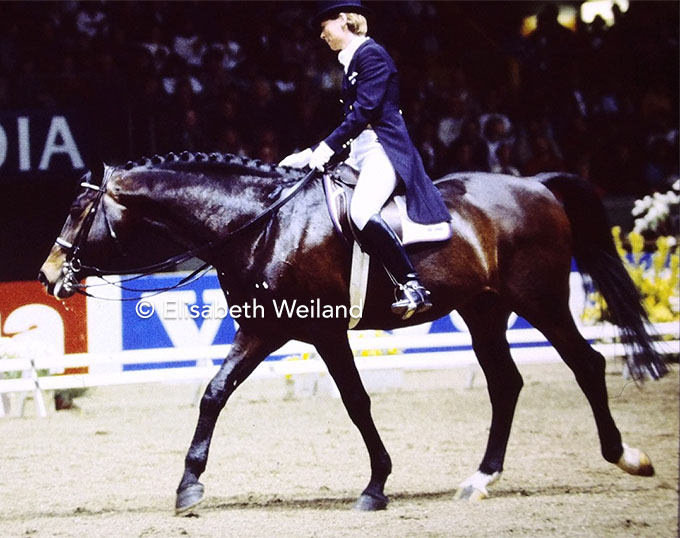
Perhaps a bit surprising, local hero Louise Nathhorst had obtained a fourth place in the Grand Prix with her 1988 Olympic partner, the small Swedish stallion Chirac (by Chagall-Cyrano) and came fifth overall after her freestyle, but she certainly enjoyed the loudest applause and most enthusiastic cheering from her home crowd which celebrated her as if she were the winner. Behind Nathhorst Canadian Ashley Nicoll managed to put future winner, Dutch Anky van Grunsven, into 7th place, riding the dark-brown Swedish bred stallion Reipo (by Emir-Utrillo).
Anky van Grunsven debuted on her first Grand Prix horse Prisco and stayed ahead of the best German in the field of 14, Hans Rüben and the Hanoverian Schiwago (by Servus) and former winner Anne-Grethe Törnblad on Marzog’s sucessor, the Danish bred gelding Supermax Ravel (by Go On Then xx).
-- by Silke Rottermann
Related Links
Blast from the Past - 1987 World Cup Finals
Blast from the Past - 1986 World Cup Finals